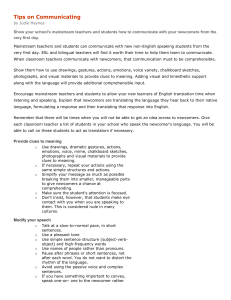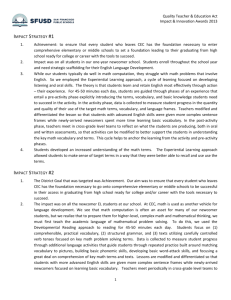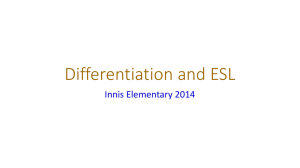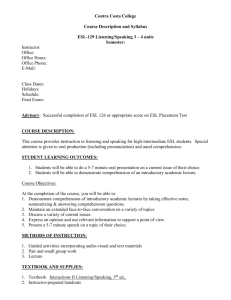ESL/Bilingual Resource Guide for Mainstream Teachers
advertisement
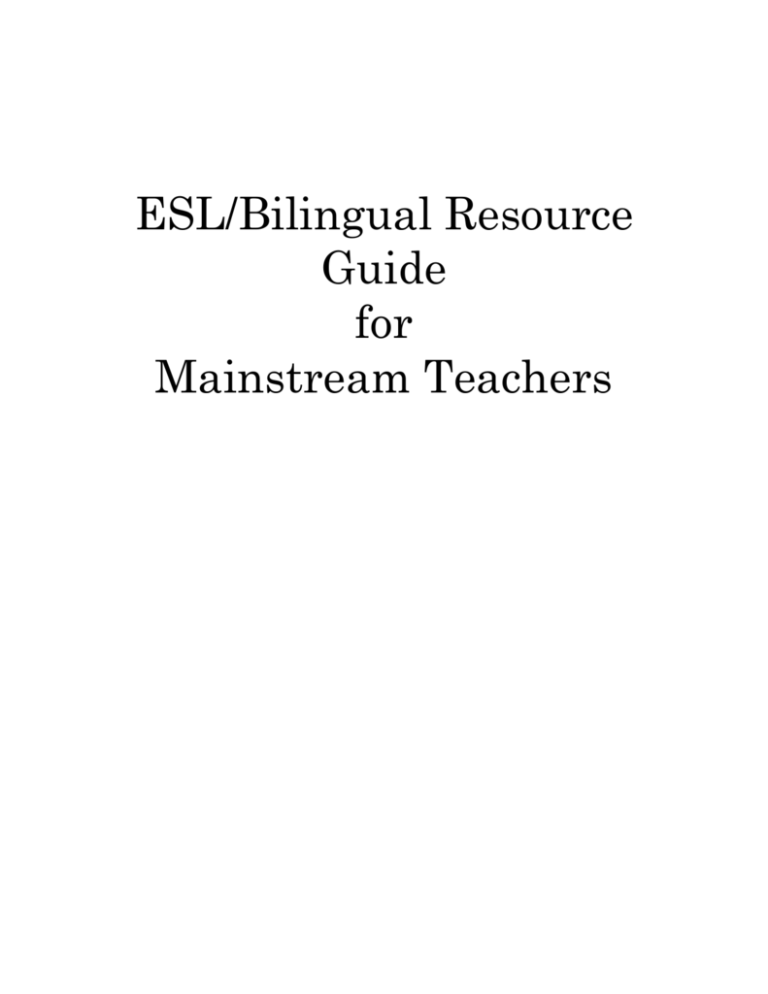
ESL/Bilingual Resource Guide for Mainstream Teachers LANGUAGE ACQUISITION CHART OFFICIAL NAME STAGE I STAGE II PREPRODUCTION EARLY PRODUCTION OTHER NAMES NEWCOMER EMERGENT SPEAKER SILENT PERIOD STAGE EMERGENT/BEGINNER ONE-TWO WORD SOCIAL LANGUAGE STAGE DEFINITION •Students not ready to actively produce language •Listening and responding in non-verbal ways to show understanding •Students can attend to hands-on demonstrations with more understanding •May initiate conversation by pointing or using single words •Very limited comprehension/vocabulary •0 – 500 receptive word vocabulary •Adjusting to U.S. culture •Up to 1000 receptive word vocabulary •Adjusting to U.S. culture • Depends heavily on context • Has minimal receptive vocabulary • Comprehends key words only • Indicates comprehension physically (points, draws, gestures, etc.) • May not produce speech • Depends heavily on context • Produces words in isolation • Verbalizes key words • Responds with one/two word answer or short phrases • Indicates comprehension physically • Mispronunciation/grammar errors • ABLE TO: observe, locate, label, match, show, classify, categorize • ABLE TO: name, recall, draw, list, record, point out, underline, organize • Use manipulatives, visuals, realia, props, games • Create climate of acceptance/respect that supports acculturation •Use cooperative learning groups • Require physical response to check comprehension • Display print to support oral language • Model activities for students • Use hands-on activities • Use bilingual students as peer helpers • Adjust rate of speech to enhance comprehension • Ask yes/no questions • Ask students to show/point/draw •Teach content area vocabulary/ terminology Continue Stage I Strategies PLUS • Simplify language/not content • Lessons designed to motivate students to talk 0 – 6 Months in U.S. School 6 Months – 1 Year in U.S. School STUDENT BEHAVIORS TEACHING STRATEGIES RELATIVE TIME LINE FOR EACH LANGUAGE ACQUISITION STAGE • Ask students questions that require one/two word responses: who?, what?, which one?, how many? • Lessons expand vocabulary Please note students progress at independent rates depending on previous schooling, acculturation, and motivation. Students with no previous schooling will take longer to progress through these stages. Please remember most English Language Learners students have extensive language ability in their first language. LANGUAGE ACQUISITION CHART (continued) STAGE III STAGE IV STAGE V LOW INTERMEDIATE HIGH INTERMEDIATE FLUENCY ADVANCED FLUENCY SHORT/PHRASES/SIMPLE SENTENCES SOCIAL LANGUAGE STAGE BRIDGING ACADEMIC LANGUAGE STAGE EXITABLE FLUENCY ACADEMIC LANGUAGE STAGE •Students begin speaking in short phrases and simple sentences • Many mistakes in grammar, word order, word usage •Limited comprehension and vocabulary •Students can communicate thoughts more completely, can participate in every day conversations without highly contextualized support •Students have advanced skills in cognitive/academic language •Up to 7,000 receptive/active word vocabulary •Up to12,000 receptive/active word vocabulary •Beyond 12,000 receptive/active word vocabulary • Depends heavily on context • Produces whole sentences • Makes some pronunciation and basic grammatical errors, but is understood • Demonstrates comprehension by responding orally and in written form (charts, graphs, diagrams) • Hears smaller elements of speech • Functions on a social level • Uses limited vocabulary • Initiates conversation & questions • Shows good comprehension (given rich context) • Depends on context • Engage in and produce connected narrative (discourse) • Shows good comprehension • Uses expanded vocabulary • Makes complex grammatical errors • Functions somewhat on an academic level • Functions on an academic level with age/grade peers • Maintains two-way conversations •Uses more complex grammatical structures • Demonstrates comprehension in decontextualized situations • Uses enriched vocabulary • ABLE TO: imagine, create, appraise, contrast, predict, express, report, estimate, evaluate, explain • ABLE TO: relate, infer, hypothesize, outline, revise, suppose, verify, rewrite, assess, justify, critique, summarize, illustrate, judge, demonstrate • ABLE TO: tell, describe, restate, compare, question, map, dramatize) Continue Stages I & II PLUS • List and review instructions step by step • Build on students prior knowledge • Incorporate more reading and writing Continue Stages I-III PLUS •Have students brainstorm, list, web, use graphic organizers Continue Stages I-IV PLUS • Incorporate note-taking skills • Study skills • Test-taking skills • Engage students in producing language such as describing, retelling, comparing, contrasting, summarizing, graphs, charts, diagrams, creating rebuses • Ask questions soliciting opinions, judgment, explanation (more why and how questions) • Introduce figurative language • Develop more academic language (oral and written) • Demonstrate how to verify answers (oral and written) • Expand figurative language (idioms) 1 – 3 Years in U.S. School 3 - 5 Years in U.S. School 5 - 7 Years in U.S. School Revised 4/24/2000 - PPS ESL/BE Department 1/2000 Essential Tips for K-12 Mainstream Teachers Working with English Language Learners v Learn how to pronounce the student’s name. v Don’t assume he/she does not speak or understand English…take the time to find out. v Students who are recent arrivals need time to adjust. v Increase your knowledge. Learn as much as you can about the language and culture of your students. Encourage students to express their points of view and opinions on different issues and share information about their culture. v Families generally speak their 1st language at home. Encourage your students to continue to speak their 1st language. v Encourage students to read in their 1st language. v Focus on vocabulary. Pre-teach vocabulary and concepts; use realia, demonstrations, visuals, and multiple modalities when teaching. Illustrate, label, explain multiple meaning words. v Read aloud! v Demonstrate; use manipulatives. Whenever possible, accompany your message with gestures, pictures and objects that help get the meaning across. Use a variety of different pictures or objects for the same idea. MODEL, MODEL, MODEL. v Make use of all senses. v Make use of visual clues and graphic organizers. Create semantic webs, cluster vocabulary, use graphs, charts, maps, timelines, diagrams to help convey meaning and check for understanding. v Access prior knowledge. Assess students prior knowledge and tap into their past experiences to make learning interesting and meaningful. v Write legibly. Some students may have low levels of literacy or are unaccustomed to the Roman alphabet. v Teach note-taking. For beginners, copying IS writing. Language experience is very appropriate. v Provide frequent opportunities for ELL students to speak. Use small groups, pairs, cooperative groups and native language groups (when possible). v Simplify your language, not the content. v Develop a student-centered approach to teaching and learning. Students can better acquire the language when activities are planned that actively involve students. v Speak directly to the student, emphasizing important nouns and verbs. Avoid slang and idiomatic expressions. New vocabulary should be presented, discussed and used prior to teaching content. v Ask inferential and higher order thinking questions. Encourage students’ reasoning abilities, such as hypothesizing, inferring, analyzing, justifying, predicting and allow them to demonstrate these abilities in nonverbal ways using charts, diagrams, drawings, etc. v Prepare and provide focus questions before you start to teach the lesson. v Recognize that students will make language mistakes. Model correct grammatical form in a supportive, friendly, respectful environment. v Cooperative groups are effective! “Buddies” are great for academics, playground, lunchroom, etc. v For beginners, adjust the amount of work or the performance standard to be reasonable. Increase requirements as proficiency and comfort increase. v Announce the lesson’s objectives and activities prior to the lesson. v Write the objectives. Use pictures, drawings, diagrams, charts, labels, etc. to illustrate what will be taught. Consider using a slower rate of speech (when appropriate), enunciate clearly, use less difficult words and/or explain vocabulary that may make the content difficult to understand. v Don’t give inflated grades. EQ:yp4/26/00 v Do not force reticent students to speak. Give students opportunities, increase wait time, respond positively to students’ attempts, and model correct grammar. v Bring the student’s home language and culture into the classroom. v Create listening stations so they may listen and read at the same time. v Fluent conversation skills do not necessarily indicate academic proficiency. Continue to use all of these strategies for teaching academic content. Suggestions for Supporting K-12 Newcomer ESL Students In The Mainstream Classroom 1. Sensitize mainstream students to the newcomers’ challenges. Prepare Englishspeaking peers for the arrival of a newcomer. Ask your students to imagine that their parents took them to another country to live. Brainstorm with them how they would feel. 2. Be aware of the effects of culture shock. Children may demonstrate physical ailments or display a wide variety of unusual behavior such as tantrums, crying, aggression, depression, tendency to withdraw, and sleeplessness. 3. Create a nurturing environment. Give lots of encouragement and praise for what the students can do, and create frequent opportunities for their success in your class. Be careful not to call on them to perform alone above their level of competence. 4. Establish a regular routine for newcomers. At first, everything will be chaotic to your newcomers. Give them help in organizing time, space, and materials. Give them a copy of the daily schedule. Tape it to their desks, or have them keep it at the front of their ESL notebooks. Send a copy home so that parents can help their children feel more connected to the classroom. 5. Engage newcomers in language learning from the beginning. Here are some ways to actively engage your newcomers in language learning. v COPY WORK Have students copy alphabet letters, numbers, their name, your name, the names of other students in the class, and beginning vocabulary words. Have them draw pictures to demonstrate comprehension of what they are copying. v ROTE LEARNING While this is not popular in American schools, it is common in many other countries. Initially, parents and students often feel more comfortable if they can see some kind of end product. You may wish to have students learn sight words, poems, chants, songs, lists, and spelling words through rote learning. v THE CLASS AUTHORITY. Each newcomer has many strengths that he or she can share with the class. When appropriate include them as resources so they too can be seen as important members of the group. Areas of expertise might be computers, math, origami, or art work. 6. Recruit volunteers to work with newcomers. At first, many students will not speak at all. It is critical to provide students with plenty of aural input in order to familiarize them with the sounds of the English language. 7. Use recorded material. A word of caution about the use of tapes and tape recorders. The student using headphones is isolated from the rest of the class. 13 Things for K-12 Mainstream Teachers to Consider When Teaching Newcomers to Read 1. Read to newcomers every day. Appropriate reading material for beginning English Language Learners (ELL) should include at least some of these characteristics. v v v v v v Numerous illustrations that help clarify the text Story plots that are action-based Little text on each page Text that contains repetitive, predictable phrases High-frequency vocabulary and useful words Text that employs simple sentence structures 2. Use reading strategies to increase students’ comprehension. When you read to beginning ESL students, be sure to make language comprehensible to them. v v v v v v v v v Point to the corresponding pictures as you read the text. Act out, dramatize, and provide models and manipulatives for students to handle. Read sentences at a slow-to-normal speed, using an expressive tone. Allow time after each sentence or paragraph for students to assimilate the material. Verify comprehension of the story by asking students to point to items in the illustrations and to answer yes/no and either/or questions. Read the same story on successive days. Pause at strategic points and invite students to supply the words or phrases they know. Point to the words in the text as you read them. This is particularly useful for students who need to learn the left-to-right flow of English text. When students are familiar with the story, invite them to “read” along with you as you point to the words. If appropriate for younger students, use Big Books, as both text and illustrations can be easily seen. 3. Teach the alphabet. Preliterate students and literate newcomers who speak a language that does not use the Roman alphabet need direct instruction in letter recognition and formation as well as beginning phonics. 4. Use authentic literature. Begin with materials that have easily understood plots, high frequency vocabulary and few idiomatic expressions. 5. Teach phonics in context. Using authentic literature, you can introduce and reinforce letter recognition, beginning and ending sounds, blends, rhyming words, silent letters, homonyms, etc. Phonics worksheets are not generally useful to the newcomer since they present new vocabulary items out of context. 6. Make sure students understand the meaning. Your students may learn to decode accurately but be unable to construct meaning out of the words they have read. Teach newcomers to reflect on what they have decoded and to ask questions to be sure they understand. 7. Check comprehension through sequencing activity. Check student comprehension with one or more of the following activities. v Write individual sentences from the text on separate sheets of drawing paper; then read or have the students read each sentence and illustrate it. v Informally test students’ ability to sequence material from a story: print sentences from a section of the story on paper strips, mix the strips; have students put them in order. v Check students’ ability to order words within a sentence; write several sentences from the text on individual strips of paper; cut the strips into words; have students arrange each group of words into a sentence. 8. Provide for audio review. Set up a tape recorder and record stories as you read. Newcomers then have the opportunity to listen to a story, and read along, as many times as they wish. 9. Teach reading in the home language first. Whenever feasible students should have an opportunity to receive reading instruction in their home language prior to receiving reading instruction in English. If you are a mainstream teacher and find yourself responsible for the developmental reading instruction of preliterate newcomers, allow newcomers time to develop some aural familiarity with English and build a vocabulary base before beginning reading instruction. 10. Encourage reading outside of the classroom. Stock your classroom library and encourage newcomers’ parents to join the public library and check out picture books, books with read-along tapes, and home-language books, if available. 11. Encourage newcomers to explore creative writing in English. Students will learn to write faster when they have real reasons to write. Motivate students to write by providing them with meaningful reasons to write. 12. Establish and English Language Learner Center. Fill the ELL Center with activities for your new language learners. Here are some of the items you may want to include in your ELL Learning Center. It is not necessary to put everything in at once. Add to the Learning Center a little bit at a time. v Tape recorder and earphones v Copies of appropriate activity pages, and keep them in a loose-leaf binder, a large envelope, or a folder with pockets.) v Crayons, scissors, pencils, erasers, and paper v An ESL notebook v An ESL folder for Dictionary pages v Labels for classroom objects v A picture file (class-made or commercial) v Well-illustrated magazines for cutting out pictures v Blank 3”x 5” index cards to be used for flash cards or concentration games v A picture dictionary v Home-language books on your newcomers’ reading levels v Home-language magazines with lots of pictures v Nonfiction picture books from the library that cover the same content material you v v v v v are currently teaching Beginning phonics books with tapes Taped music in both English and home language Picture books and well-illustrated beginning-to-read books with tapes Simple games: dot-to-dot activities, word searches, concentration games, sequencing activities, and jigsaw puzzles An “object” box containing small manipulative objects for beginning vocabulary or phonics learning. 13. Make up individualized Starter Packs for your newcomers. The Starter Pack enables entry-level students to work independently on activities suited to their specific needs. Encourage students to work on these activities when they cannot follow the work being done in the classroom. Remember, however, not to isolate the newcomers from their peers with separate work all day long. They, too, need to be a part of your class and should be integrated as much as possible. List of Terms Related to ESL/Bilingual Programs BICS: Basic Interpersonal Communication Skills. Social Language that is less cognitively demanding Bilingual Instruction: Instruction using two languages, usually the student’s first language and a second language CALP: (Cognitive Academic Language Proficiency) Language proficiency related to academic setting. Language that is more intellectually demanding and abstract Comprehensible Input: The language the learner already knows plus a range of new language that is made comprehensible by the use of planned strategies Content-Based ESL: A second language learning approach where teachers use instructional materials, learning tasks, and classroom techniques from academic content areas to develop second language, content, cognitive and study skills Culture: The sum total of the ways of life of a people; includes norms, learned behavior patterns, attitudes, and artifacts; also involves traditions, habits or customs; how people behave, feel and interact; the means by which they order and interpret the world; ways of perceiving, relating and interpreting events based on established social norms; a system of standards for perceiving, believing, evaluating, and acting ELL: English Language Learner ESL: English as a Second Language Home Language: Language(s) spoken in the home by significant others (e.g., family members, caregivers); sometimes used as a synonym for first language, primary language, or native language Language Proficiency: The level of competence at which an individual is able to use language for both basic communicative tasks and academic purposes LEP: Limited English Proficient NEP: Non-English Proficient Newcomer: Any non-English speaking student who has never attended American schools and is new to this country PHLOTE: Primary Home Language Other Than English Primary language: First or native language spoken by an individual Pull-out Instruction: In the case of ESL pull-out instruction, when students are withdrawn from their regular classrooms for one or more periods a week for special classes of ESL instruction in small groups Realia: Concrete objects used to relate classroom teaching to real life (e.g., use of actual foods and supermarket circulars to develop the language related to foods, food purchasing) Sheltered Instruction: An approach in which students develop knowledge in specific subject areas through the medium of English, teachers adjust the language demands of the lesson in many ways, such as modifying speech rate and tone, using context clues and models extensively, relating instruction to student experience, adapting the language of texts or tasks, and using certain methods familiar to language teachers (e.g., demonstrations, visuals, graphic organizers, or cooperative work) to make academic instruction more accessible to students of different English proficiency levels REFERENCES FOR IMMERSION Ada, Alma Flor (1990). Spanish-Language Children’s Literature in the Classroom. Compton, CA: Santillana Publishing Co. Christian, Montone, Lindholm, Carranza (1997). Profiles in Two-Way Immersion Education. McHenry, IL: Delta Systems. Cloud, Genesee, Hamayan (2000). Dual Language Instruction. Boston, MA: Heinle & Heinle. Curtain, Helena & Pesola, Carol (1998). Languages and Children: Making the Match. Longman, NY: Longman Publishing Group. Freeman, David E. & Yvonne S. (1994). Between Worlds, Access to Second Language Acquisition. Portsmouth, NH: Heinemann. Freeman, David E. & Yvonne S. (1997) Teaching Reading and Writing in Spanish in the Bilingual Classroom. Portsmouth, NH: Heinemann.
